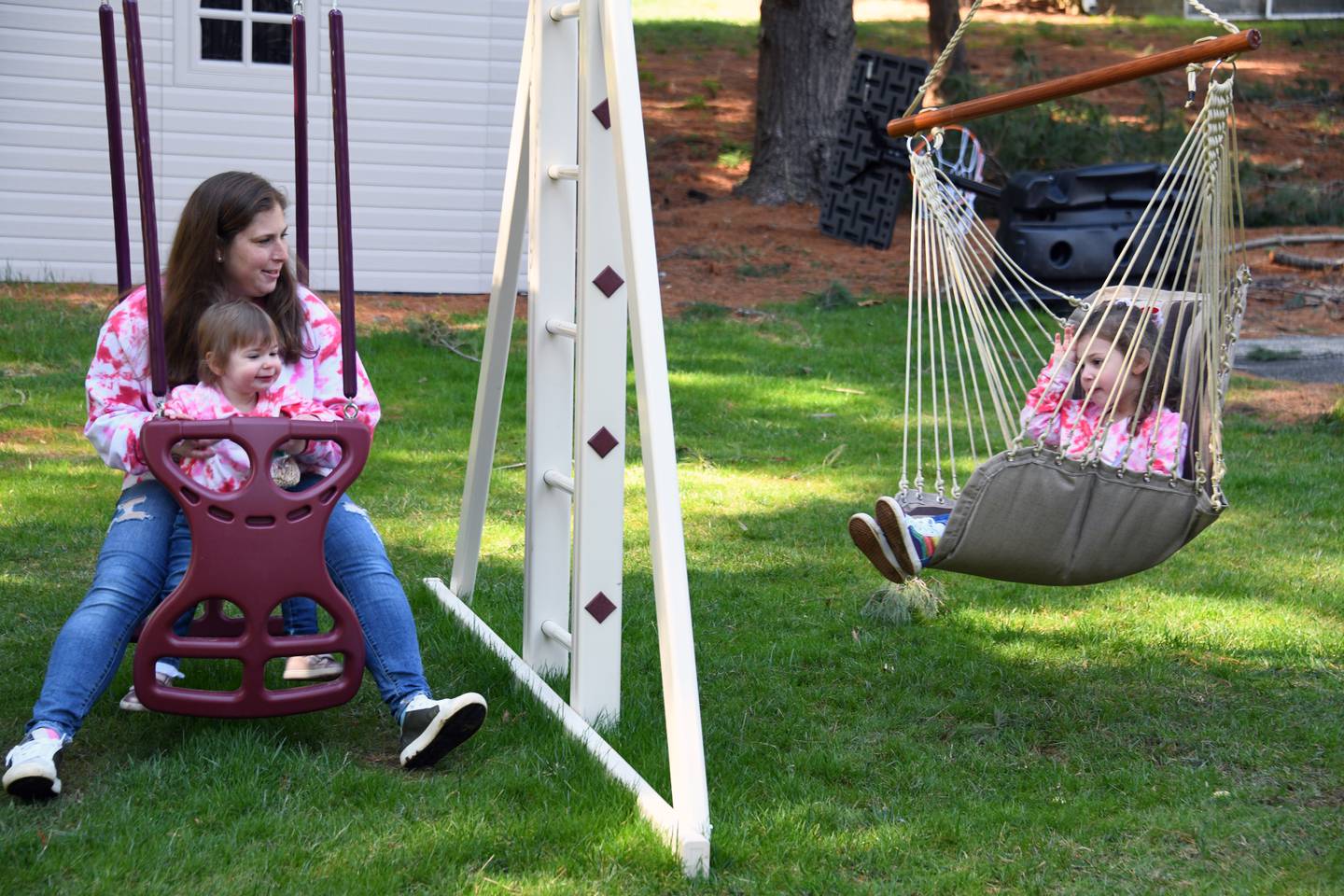COVID vaccines will soon be available for kids under 5. Experts worry many parents won’t see the need.
Terry Golaner is counting the days until her two youngest children can be vaccinated against the coronavirus, continuing with masks and careful consideration of social activities.
“I feel like my two younger ones potentially could be sitting ducks,” the Pikesville mother said. “At some point we all may have COVID, but I want them to have the vaccine because I don’t want them to end up in the hospital or with long-haul COVID or die.”
Advertisement
The wait is frustrating, especially with much of the public moving on from the pandemic as cases plummet and mandates lift.
What’s worse for public health officials staring down a possible new wave of infections from another omicron subvariant called BA.2 is the fear other parents won’t see a need to get their kids vaccinated when the U.S. Food and Drug Administration authorizes it for children under age 5, as soon as April.
Advertisement
The percent of fully vaccinated Americans has stagnated at about two-thirds. Just under half of those eligible have gotten a booster dose. Federal regulators authorized a second booster last week for older and immunocompromised people, but it’s unclear how many people will want those either.
Children remain the least protected with about 35% of parents of those aged 5 to 11 choosing to vaccinate their kids since they became eligible in November.

A Kaiser Family Foundation survey found even greater hesitancy among parents of younger kids. Only 1 in 5 parents said they will follow Golaner’s plan to immediately vaccinate their children aged 6 months to 5 years, the survey found. About a quarter said they’d wait and see, 15% said they’d do it only if required and 35% said they would not vaccinate.
“We do need to do better, but I’m not sure we know how to do that anymore,” recently lamented Dr. William Moss, executive director of the Johns Hopkins International Vaccine Access Center. “At this stage of the pandemic, it’s hard to convince people. We pay a high price for that.”
He and colleagues said the low vaccination rate among those aged 5 to 11 is an ominous sign about coverage for the younger ones.
Children have largely weathered the virus, with about 12 million reported cases and fewer than 1,000 deaths. But 5 million of the youth cases have been recorded so far in 2022 alone, boosting the number of hospitalizations. Long-term effects remain unknown.
Some new — and old — methods are being deployed to persuade parents to get their children and themselves vaccinated.
In Maryland, with higher than average vaccination rates, Gov. Larry Hogan has consistently pushed both vaccination and boosters with lotteries and other means, and the state has continued to offer testing and vaccinations at sites including hospitals.
Advertisement
Demand has waned, but the Maryland Department of Health keeps testing and vaccinations sites in “warm” status, or ready to ramp back up if needed.
“If we need to utilize these sites, we can staff them, stock them with inventoried supplies and have them operational very quickly,” said Andy Owen, a department spokesman, adding the state continues to monitor cases, including testing for BA.2.
Federal funding for such efforts is expected at least through June.
“We are actively planning for the availability of COVID vaccines to Marylanders under age 5 based on the latest federal guidance and information,” Owen said.
Rupali J. Limaye, director of behavioral and implementation science at Johns Hopkins’ International Vaccine Access Center, has helped develop a course about how to talk to people about vaccinating their children.
“So far the messaging is that COVID in kids has been mild,” she said. “But we’re seeing increases in hospitalizations for children in recent months. And we’ve seen a lot of kids in this age range have long-term effects as well.”
Advertisement
Limaye thinks the shifting advice, and now dropping mandates, has sent mixed messages about the need for vaccines and maybe the tactics need to change.
“The best thing may be moving away from the messaging coming from the health care system,” she said. “Make it more peer-to-peer, with more interpersonal communication, grounded in empathy. … Target the moveable middle.”
Delays in authorization of vaccines for the youngest kids may further reduce uptake, she said.
The FDA put off consideration of the low-dose, two-shot Pfizer-BioNTech vaccinations in February because it wasn’t as effective as expected in young children. The drug makers are testing three doses.
Similarly, Moderna’s two doses didn’t reach the 50% effective rate that the CDC set as a threshold. But experts believe that is because it was tested during the surge of omicron, which has been better at evading protections.
But both vaccines are expected to offer significant protection from severe disease for young children.
Advertisement
Effectiveness is definitely a concern among the vaccine hesitant, said Rev. Derrick DeWitt, senior pastor of First Mount Calvary Baptist Church.
DeWitt was enlisted as a messenger, serving as a vaccine ambassador for the state of Maryland, encouraging everyone, but especially African Americans, to get their shots.
He said he’s heard every excuse from concerns about how quickly the COVID vaccine was developed, though the mRNA technology has been around more than a decade, to conspiracy theories about implanted chips.
“I heard no way, no how am I ever going to do this, and my kids are not going to do this,” said DeWitt, who mandated vaccination for staff at the Maryland Baptist Aged Home, where he also serves as president of the board, when only 11 of 60 employees initially opted for vaccination.
Teens seemed especially receptive to conspiracy theories they find online, said DeWitt, who believes schools may have to mandate vaccination. That could increase uptake to like 80%, with the remainder convinced when nothing bad happens to their friends.
For now, DeWitt has turned to incentives, such as handing out food along with a shot and a COVID test.
Advertisement
“We’re giving away video games and gift cards along with food,” he said. “Some call it gimmicks. But we had to develop a way to get people to register.”
The Baltimore Community Foundation recently received $700,000 in funding from the U.S. Centers for Disease Control and Prevention to hand out to leaders like DeWitt, with an emphasis on Black and Hispanic residents of Baltimore city and county aged 18 to 34 — in many cases parents of young children.
Groups can apply on the foundation website, and the foundation also is working with Michigan State University to analyze what methods work best.
The outreach and the research will both be crucial for this and the next pandemic, said Kiara Mayhand, a public health fellow at the foundation spearheading the initiative.

Breaking News Alerts
As it happens
Be informed of breaking news as it happens and notified about other don’t-miss content with our free news alerts.
“Getting vaccinated is what we know works and is our best option to protect ourselves and our families,” Mayhand said. “We’re uncertain about what the next phase of the pandemic will hold.”
The public health experts know reaching children and their parents remains a heavy lift, with the Baltimore health department reporting only about a quarter of kids 5 to 19 are fully vaccinated, compared with 75% of those over age 60.
Advertisement
About 44% of Black residents are vaccinated compared with about 60% of white residents and 67% of Hispanic residents.
Golaner, the Pikesville mom, said she understands that people may have trouble getting good answers about the vaccines for themselves and their kids if they don’t have people they trust to ask like she does. Her brother is a has a doctorate in biochemistry, her mother is a nurse and she’s also worked in health care.
But she believes that education can work and is needed to boost vaccine rates that also protect her children, ages 11, 4 and 20 months until they get their shots.
Even then, she doesn’t expect it will end the efforts.
“COVID isn’t going to go away,” Golaner said. “It’ll be a part of our lives. We get a flu shot every year and we’ll get COVID shots if we have to. I want them protected from the really bad stuff.”
This article has been archived for your research. The original version from Baltimore Sun can be found here.


